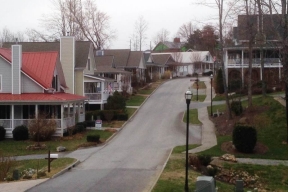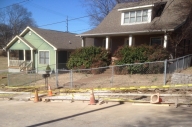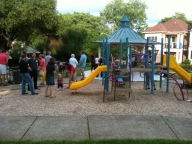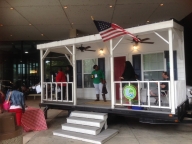Neighborhoods
Healthy neighborhoods have been shown to improve the quality of people’s lives. Neighborhoods can strengthen the social and economic well-being of people that live in them. Organized neighborhoods are better able to response to community needs. Neighborhoods can thrive through more informed and involved citizens. Improving the safety and health of homes revitalizes a community. Safe and accessible neighborhoods have infrastructure like roadways, bike paths, green space and sidewalks that improve the quality and appearance of the neighborhood as well as improve connectivity to people, recreation and jobs. Healthy neighborhoods help to increase home values, market the community, create high standards for property improvements and forge strong connections among neighbors.

How are neighborhoods defined?
How can neighborhoods encourage physical activity?
What do people like having in their neighborhoods?
How can neighborhoods do to benefit children?
How can neighborhoods do to benefit older adults?
What are some topics neighborhoods are concerned about?
How can neighborhoods participate in planning?
What is a neighborhood watch?
How can neighborhoods change?
How can anchor institutions lead?
What can neighborhoods do to build community?
What is a food desert?
What is my area Human Resource Agency?
What tools are out there for neighborhoods?
Government partners
Additional resources
Helpful documents
How are neighborhoods defined?
Neighborhoods are defined by the people that live in them. Neighborhoods are geographically connected communities of people. Neighborhoods are social communities as people are close together allowing for frequent personal interactions. Neighborhoods are groups of peoples’ homes from houses to apartments and condos to manufactured homes. Though, neighborhoods are more than just houses with schools, workplaces, restaurants, faith-based places, parks and other places.
Neighborhoods are social units in the sense that they are not directly controlled by government. People choose how and where to participate in neighborhood interactions. Neighborhoods often cut across boundaries set up by government such as Census blocks or voting districts or even roads or landscape. Ultimately, neighborhood boundaries are determined by the residents.
Neighborhoods are unique. The cultural norms, values and interests can vary greatly from a neighborhood in one part of town to another part of town and certainly from city to countryside. While some may seem similar, no two are alike as the people and places change from neighborhood to neighborhood.
One thing that remains true across neighborhoods is those that are well designed to serve all members of their community, including the young, old and those with disabilities, are more likely to thrive. Thriving neighborhoods also increase property values. Healthy neighborhoods improve the quality of their residents’ lives.
How can neighborhoods encourage physical activity?
Neighborhoods can be great places for people to achieve their physical activity goals. Walking the dog, pushing the stroller, going for a jog, meeting up for socialization and relaxing in the park are great ways to be physically active within neighborhoods. Neighborhoods need to be perceived as safe to those who live, work and play there to successfully encourage physical activity. Designing neighborhoods that are connected places allows people to choose to walk, roll or otherwise actively move from place to place. Neighborhoods with short blocks, connectivity and low traffic speeds are good for people to move about without a car. Neighborhood designs that include connected active transportation choices, proximity to parks and social places tend to increase physical activity. Everything from sidewalks, bike lanes, greenways and transit stops help people increase physical activity. Well-designed neighborhoods have been shown to help some of the least active people get some physical activity into their daily routines.
What do people like having in their neighborhoods?
Public spaces are best when focused on how people use and benefit from the space. Here are some ideas to consider to help make neighborhood placemaking more inviting to people:
- plazas,
- benches,
- parks,
- trees,
- landscaping,
- water features,
- historical markers,
- murals, and
- public art.
What can neighborhoods do to benefit children?
Neighborhoods that are well-designed serve all members of the community including the young, old and those with disabilities. Some ideas to consider that will benefit children include:
- buffers between sidewalks and street traffic,
- safe paths and places to ride bikes, skateboards, scooters, etc.,
- parks and green space,
- playground equipment for various age children,
- ballfields and sports leagues, plus
- safe routes to school.
What can neighborhoods do to benefit older adults?
As the baby boomer generation ages into retirement, seniors prefer to remain in the same communities where they worked and raised a family. Older people have different needs when it comes to remaining physically active as they age. Much more information can be read on our Healthy Aging webpage. Here are some things to consider that will benefit seniors in your neighborhood:
- places to sit and rest,
- ramps instead of steps,
- handrails for stability,
- shade from hot sun, and
- senior centers.
What are some topics that neighborhoods are concerned about?
Even the happiest neighborhoods have concerns. Some topics that residents are concerned about in their neighborhoods are city councils, school boards, racial justice, safety, crime, police, fire protection, new construction, streets and traffic, housing, leadership training, litter cleanup and beautification, sidewalks, opportunities for youth, gentrification and planning.
How can neighborhoods participate in planning?

Neighborhoods are full of people. People can vote. People can act as individuals or in well-organized groups. Neighborhood associations can be a strong voice for positive change. Some neighborhood associations get non-profit status in hopes of getting grant money. Neighborhood associations often know the collective interests of their residents. They can also be organizers to help gather individual residents for important public meetings or other public input opportunities. Neighborhood associations can converse with government officials or when all else fails, get the attention of news media.
What is a neighborhood watch?
A neighborhood watch is a group of concerned residents organized together to prevent crime. Simply put, when people keep an eye and an ear on their communities, it deters crime. A neighborhood watch is a great way for neighborhood volunteers to work together with law enforcement to make safer communities. According to the National Crime Prevention Council, Neighborhood Watch is one of the oldest and most effective crime prevention programs in the country.
How can neighborhoods change?
Neighborhoods can change in many ways, both positive and negative. Sometimes changes are perceived by the residents and other times changes are very real. Both real and perceived changes are important to shaping and maintaining neighborhoods that support health. Neighborhood revitalization is a process of rebuilding neighborhoods to create new opportunities. Revitalization creates opportunities for not only residential housing options but also for planning, beautification, entrepreneurship, business development, transportation and public spaces. It is the opinion of many people that revitalized neighborhoods help cities and towns grow into places people want to live, work, learn and play.
Gentrification occurs when neighborhoods increase in property value to the point when lower-income families and businesses are displaced. In a community experiencing gentrification, costs increase to the point where some residents are unable to afford rent or property taxes making it necessary for them to relocate. Gentrification is changing demographics, real estate markets, land use and culture. Gentrification is becoming a more common topic as some revitalized neighborhoods change. Some people view the population changes as negative while other people view the changes as positive reinvestment in their community making it an even better place to be.
How can anchor institutions lead?
Anchor institutions are the major employers and property owners of a community. Anchor institutions such as government offices, universities, hospitals, factories, call centers and big box stores can be catalysts for economic and community development. These large entities can take on a variety of roles from building infrastructure to purchaser of local goods or even redeveloper of blighted real estate. Anchor institutions can assist communities’ health needs by supporting social determinants of health like neighborhood safety, community engagement and continuing education.
What can neighborhoods do to build community?

Here are some ideas to build community in your neighborhood:
- use signage to identify the neighborhood,
- get to know your neighbors,
- enjoy picnics or potlucks with neighbors,
- host an annual event or festival,
- meet as a neighborhood association,
- plant a community garden,
- set goals for community development and beautification,
- pick up litter and plant trees,
- help older residents who cannot physically maintain their home,
- form a neighborhood watch to increase security, and
- celebrate your successes!
What is a food desert?
Some neighborhoods do not have access to affordable and healthy foods choices. Sometimes these areas are called food deserts. Eating a nutritious diet is important to help prevent diabetes, cardiovascular disease, obesity and certain cancers. Neighborhoods benefit from having proximity to grocery stores, retail stores, farmers markets and community gardens. Visit our Food & Nutrition webpage for more ideas.
What is my area Human Resource Agency?

There are ten Human Resource Agencies in Tennessee. These agencies deliver social services across the state to help people to have a sense of self-worth and wellbeing. Their services cover a broad range of human needs including children and youth; community services; community intervention; education and employment; nutrition; elderly and disabled; housing; transportation; and healthcare.
What tools are out there for neighborhoods?
Many cities and towns have a way for neighborhood groups to register with the local government. This sharing of contact information improves the sharing of information. It helps local governments keep their neighborhoods informed of activities and opportunities. It also provides a way to alert neighborhoods about forthcoming changes or proposals for new development. Many tool kits have been developed to help neighborhood groups organize and strategically plan, some of which are noted as additional resources below. Many neighborhoods have published their successful strategies on the Internet; a quick search will show lots of great neighborhood ideas. Social media is a new tool for neighborhoods. There are many options for neighbors to be friends in the virtual world now in addition to the real world. Celebrate National Good Neighbor Day each year on September 28.
Government partners
Centers for Disease Control and Prevention (CDC)
Physical Activity – Community Strategies
www.cdc.gov/physicalactivity/community-strategies/index.htm
Healthy Communities Program
www.cdc.gov/nccdphp/dch/programs/healthycommunitiesprogram
U.S. Environmental Protection Agency (EPA)
Smart Growth Resources
www.epa.gov/smartgrowth/smart-growth-small-towns-and-rural-communities
Additional resources
Neighborhoods USA
nusa.org
NeighborWorks America
Health
www.neighborworks.org/community/health
National Crime Prevention Council
Neighborhood Watch
www.ncpc.org/resources/home-neighborhood-safety/neighborhood-watch
Helpful documents
AARP
Road Map to Livability (series)
www.aarp.org/livable-communities/tool-kits-resources/info-2017/roadmap-to-livability-collection.html